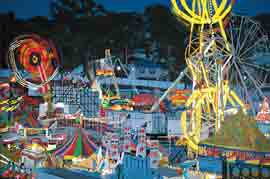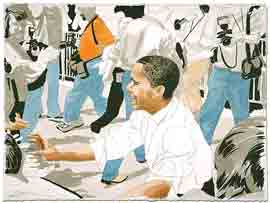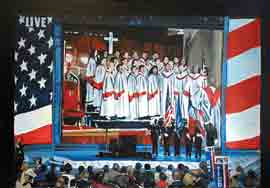 Iowa
Pastimes, Thomas C.
Jackson's current exhibit of paintings at the Figge Art Museum, is
filled with vivid observations of two American institutions filtered
through the single eye of the artist's camera. Both worlds -
political conventions and the Iowa State Fair - are spectaculars
with bright lights, designed to generate excitement and movement, and
they make their appeals to the great cross section of America.
Iowa
Pastimes, Thomas C.
Jackson's current exhibit of paintings at the Figge Art Museum, is
filled with vivid observations of two American institutions filtered
through the single eye of the artist's camera. Both worlds -
political conventions and the Iowa State Fair - are spectaculars
with bright lights, designed to generate excitement and movement, and
they make their appeals to the great cross section of America.
Jackson's political images are filled with surreal photo ops of candidates before the American public via TV cameras. His state-fair paintings also highlight the glowing and artificial, yet with a genuinely human portrayal of the American carnival.
The intended meaning of the work can be gathered not only from his choice of images but from the irony in some of his titles: Senator Biden at the Hy-Vee Grocery Store, in which the candidate is speaking only to a hand-held TV camera; America Votes, ripe with symbolic images of family values; and Deep Fried Twinkies, in which a healthy-looking woman smiles for the camera. Reality is never quite real, and illusions are part of the American experience.
Distilled Advertising
Jackson works between the edges of realism and abstraction. In his paintings, he often concentrates highly realistic detail into specific sections of his compositions, especially on the candidates. He frequently leaves the rest of the painting loose and unfinished, as if these areas are unimportant because they're not in the camera's eye.
In the large painting Democratic Convention, Jackson shows blurred American flags swirling above the upraised hands of the floor delegates, and in the horizon under darkened roofs glow the blurred distant lights of the broadcast booths of the convention. The source image for the painting was even a photograph of a TV screen.
But even though the drama is orchestrated, the waving American flags pull at our hearts. Even without sound, we respond to what is happening in the swirling mass of colors, because we have all seen this image before on our TVs. The symbols easily reach us. The artist paints the power of the media theatre and also its effect on us. "Each painting makes the viewer think about politics, the media, or daily life," Jackson wrote in his artist statement. "I strive to make relevant, memorable American images that make people think."
Sometimes his paintings turn into a field of semi-abstract colors and forms, as in Republican Convention. Here, Jackson paints an immense sea of repeated red, white, and blue banners of the number "4" and the letter "W," highlighted in a soft pool of luminescence. The edges of the painting fade out into darkness. The individual elements are important not separately but as components of the spectacle of mass marketing.
 In
America Votes: 2004 Republican
Convention, a choir, in
front of a cross, is projected onto an enormous screen. On the stage,
a military honor guard, framed by huge American flags, salutes the
delegates on the convention floor. What we are witnessing is an
outsized political advertisement of manipulated symbols, painted by a
former advertising executive.
Who would recognize and
understand the impact of these symbols better?
In
America Votes: 2004 Republican
Convention, a choir, in
front of a cross, is projected onto an enormous screen. On the stage,
a military honor guard, framed by huge American flags, salutes the
delegates on the convention floor. What we are witnessing is an
outsized political advertisement of manipulated symbols, painted by a
former advertising executive.
Who would recognize and
understand the impact of these symbols better?
Jackson told me in a conversation that he begins his work by drawing from his photographs or, for quicker execution, projecting his slides. He lightly draws out his images like a watercolor artist. Then, using large batches of pre-mixed oil colors, the artist works quickly on the canvas, asking many people what they think of his piece in progress.
In this way, he's like a creative director for his art, using focus groups and mimicking advertising in oil paints. His work does not so much transcend his material, but instead he uses advertising as a source and distills and clarifies the medium.
With Selling Social Security, we are met with a large and loosely painted brownish-gold work, with only the face of the president - working the crowd - in full detail and color. Behind him hovers his flat blue shadow, cast from the intense light of the media cameras. Hovering around and nearby the president are numerous white flashes from the collars of the half-painted Secret Service men, who are giving security to the president. The artist is playing with double meanings, evoking concern about the future of a social program in the title and then re-casting those words in the context of a political rally.
This same idea of the unsettling reality of politics occurs in Senator Biden at the Hy-Vee Grocery Store, in which the senator, the interviewer, and the cameraman are each focusing on their separate work, no one looking at anyone else. There's no human interaction here, only the senator speaking into the camera to address the unseen viewers.
This physical scene might as well not exist, because the only thing that matters is what is seen by a distant audience.
Out of the Spotlight
Similarly painted yet less judgmental vignettes of American life are mingled throughout the exhibit. Here the camera eye has turned to another spectacle: the Iowa State Fair, full of color and movement. But in Jackson's sometimes-spectacular views, there is more optimism and play. People are smiling, but not for an audience. Life is natural, despite the carnival setting.
 In
one of the most beautiful paintings, Double
Ferris Wheel, we see the
state fair at night from a high vantage point. Behind the tops of the
trailers and buildings is a dark hill with dim trees. In the middle
ground is a multicolored tent, and dozens of lights illuminate the
dark. But before us, and occupying almost the full height of the
image, are the turning and glowing red, white, and yellow neon lights
of the ferris wheels, rising like colorful idols. Everything is
shifting and changing and gives off a cheerful life. One can almost
hear the music and the crowds and smell the corn dogs.
In
one of the most beautiful paintings, Double
Ferris Wheel, we see the
state fair at night from a high vantage point. Behind the tops of the
trailers and buildings is a dark hill with dim trees. In the middle
ground is a multicolored tent, and dozens of lights illuminate the
dark. But before us, and occupying almost the full height of the
image, are the turning and glowing red, white, and yellow neon lights
of the ferris wheels, rising like colorful idols. Everything is
shifting and changing and gives off a cheerful life. One can almost
hear the music and the crowds and smell the corn dogs.
Similarly, in State Fair, swirling lights of yellow, green, red, and orange hover in the night sky like spaceships above a half-seen crowd, indistinct in the shadows, with a horizon line of red-and-white ticket and cotton-candy signs. People are slightly out-of-focus in their movement. We are left with the suggested image of the night full of warm colors and energy. Although there's something slightly unreal about this spectacle, it is more genuine than Jackson's works about the conventions. One series portrays feigned drama under the intense spotlight of the media, while the fair paintings feel relaxed, more human.
There's joy and wit in these Iowa State Fair paintings. In Deep Fried Twinkies, the artist's wife - who, I heard in conversation, is very health-conscious - stands smiling before a vendor of all that is not good to eat. The edges of the painting fade lightly into darkness; her form is the main focus. Everything in the painting is seen clearly, closely painted, and with affection.
This painting might be a performance, but it's a pleasant one without agenda, and a perfect antidote to the calculated theatre of politics.
The exhibit continues through September 9.










